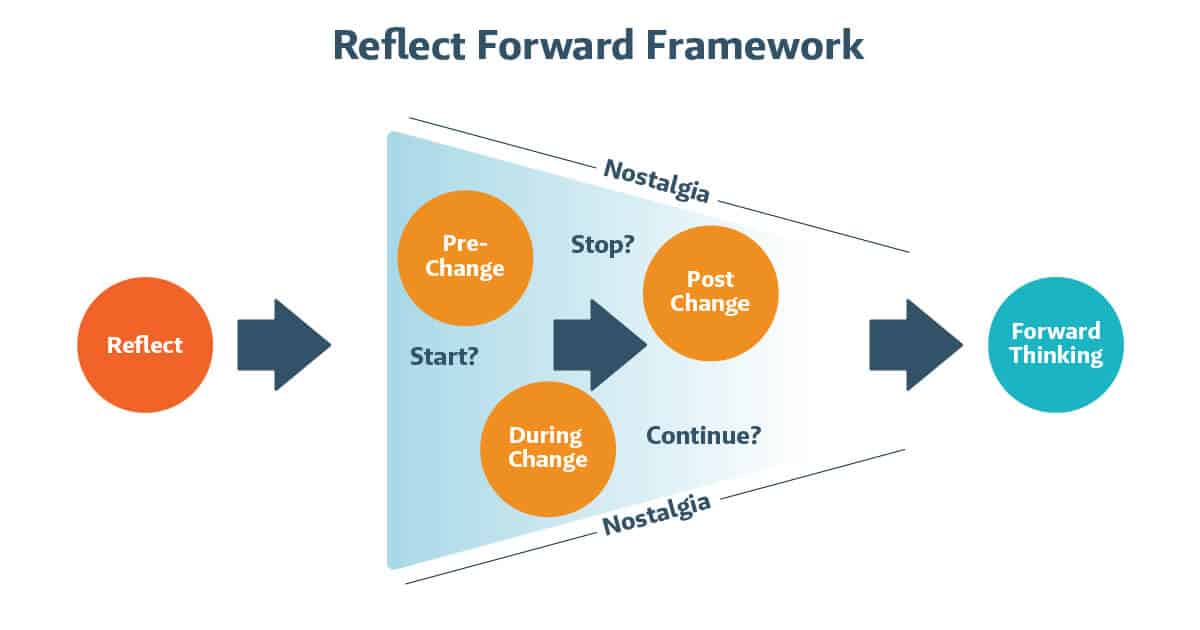As more people return to the workplace and companies regain a sense of normalcy after the COVID-19 pandemic, many business leaders want to move past all the recent troubles and look ahead to the future – and help their employees do so as well.
Helping businesses accomplish this is why the Insperity team created the Reflect Forward Framework.
The catalyst for creating the Reflect Forward Framework
In the early days of the pandemic, almost everything about how we work shifted abruptly and significantly, with no clear roadmap for navigating the situation. For example:
- Businesses closed indefinitely.
- Entire industries were crushed.
- Business processes and even entire business models had to change to serve customers while still accommodating health and safety protocols.
- For many employees, home became the new work space. As a result, they had to adapt to working alongside the distractions of family members and pets, accepting longer work hours and a diminished work-life balance, and learning new technologies they may have never used before.
- Office policies surrounding sick leaves and personal leaves had to be reevaluated. Some policies, such as those governing remote work, had to be created quickly and on the fly.
Now, businesses are grappling with issues such as:
- Whether to require the COVID vaccine for employees
- How to modify office environments to comply with health and safety protocol as more people return to on-site working
- The permanency of changes to business processes and models
- What employees’ schedules will look like for the foreseeable future – whether that’s 100% remote work, flexible hybrid schedules or a complete return to the office
- How all of these decisions will impact recruiting and retention
- How diversity, equity and inclusion initiatives will be put into action, in light of all recent social turmoil
Faced with volatility, uncertainty, complexity and ambiguity at every turn, many of us have realized that we existed in workplaces characterized by:
- Weak to nonexistent business scenario planning
- Lack of preparedness for unexpected changes
- Cultures and systems that weren’t as agile as we anticipated
- People whose mindsets weren’t as resilient as we thought they were
For many managers throughout the pandemic, it has felt like leading on quicksand.
Business leaders often emphasize the importance of learning continuously, innovating and embracing change to spur progress. Yet, when we’re faced with a major disruption that should inspire us to do these very things, we tend to cling to what we know – what’s familiar and safe, but what can keep us stuck and hold us back – or how we wish the situation was.
It’s simply human nature.
Of course, none of us had ever lived through a global pandemic before, much less planned for it. As a result, we learned a lot of hard lessons. Those in management roles reflected on how they can do better going forward with COVID and for the next time profound change happens – both in their own actions and mindsets, and as the leaders of others who may be struggling with change.
This is the context in which the Reflect Forward Framework came about.
[wistia_video thumbnail=”/wp-content/uploads/navigating-the-hybrid-workspace.jpg” video_id=”q5gbum0ht9″ class=”wp-image-381000″]
Understand the nuances of navigating the hybrid workspace – from remote work, to flexible schedules and resiliency amid change – via Insperity’s webinar “Navigating the Hybrid Work Space” hosted by Cindy DeMarco, manager of Middle Market Strategic Consulting Services, and Megan Manion, director of Customer Operations Development.
The framework defined
The Reflect Forward Framework combines existing change-management theory and infuses it with social psychology about how people process major changes.
The purpose of the framework is to:
- Help leaders guide their team through periods of crisis and disruption
- Encourage them to consider what their employees are going through as changes are adopted, so they can better address those concerns and anxieties
The desired result of leveraging the Reflect Forward Framework:
- Successfully returning to the workplace following the COVID-19 pandemic
- Ensuring business recovery
- Generating a sense of confidence and optimism so everyone can move on
Businesses should also find the framework helpful in overcoming any type of extended, episodic crisis, major disruption, social turmoil or business challenge that they may encounter in the post-pandemic future.
The process of accepting and facilitating change, and moving forward

According to Lewin’s change-management theory, there are three main stages that anyone experiencing change goes through.
Throughout each of the following stages, these actions happen continuously:
- Stop: Cease doing what clearly doesn’t work.
- Start: Modify actions to bring about improvement.
- Continue change management: Proceed with what’s working well, perhaps with minor alterations to increase the organizational benefit.
The three stages of change:
1. Pre-change
Evaluate what once was (the processes and norms that people are used to).
2. During change
What are people experience in the middle of turmoil, as the highest levels of complexity are unfolding?
Leaders ask questions such as:
- What has changed internally and externally?
- What has remained the same?
- What are we holding on to unnecessarily?
- What won’t work anymore?
- What does it look like to let go of things that aren’t relevant and won’t serve the company well going forward?
They talk to customers, survey employees and gather data.
This is also when leaders undertake many different types of analysis to assess the current state of affairs and devise plans for what may work going forward, such as:
3. Post-change
This is where people assess how well the new course of action is going, more permanently adopt changes that are working well, adapt their behavior and mindset, and detach from what they miss from the past or hoped would exist in the present.
And then there’s nostalgia.
Nostalgia
That yearning for a time that once was, which we all experience at one point or another. This emotion comes into play most commonly in the during change phase, but it can happen in any of the three change-management steps.
There are two main types of nostalgia:
1. Restorative nostalgia
This mindset is about reconstructing and reliving a past that’s more comfortable, familiar and preferable. It’s a normal feeling to want to go back to how things used to be, especially in times of upheaval. In this stage, employees resist or question changes and may express anger and frustration.
Don’t let employees dwell in this mental space too long – it can be easy to become stuck in the past. Unfortunately, when this happens, employees become disengaged or discouraged with the present. In more extreme cases, they may quit, retire earlier than planned, change careers or start engaging in behaviors that initiate the disciplinary process, for example.
2. Reflective nostalgia
This mindset may still entail wistful longing for a past that’s perceived as better. However, by this stage, acceptance of the present and future has occurred. Employees have mourned the loss, and understand the reasoning behind certain changes and have let go of what needs to be left behind. People are ready to move forward with new strategies, processes and plans.
Putting it all together
To operationalize the Reflect Forward Framework, leaders start with two primary questions:
Question 1: Reflect. What did we learn? (Leveraging Start, Stop and Continue with Change Management, and allow for restorative nostalgia to process)
Question 2: Forward. How do we adjust based on what we’ve learned? (Leveraging Start, Stop and Continue with Change Management, and shift from restorative nostalgia to reflective nostalgia)
The idea is that by taking time to reflect on what they’ve learned and assessing the current state of events, leaders can come up with a plan for what actions to continue or what to do differently moving forward.
The goal: transformational leadership
There’s no going back to what was considered normal before the start of 2020. And further change is inevitable. After all, we’re now firmly in the Flex Era, which will requires agility in the way we work.
For leaders, it’s not just about reflecting, performing analysis, making decisions and taking action during times of upheaval.
The Reflect Forward Framework encourages transformational leadership.
Leaders must be mindful of how changes impact employees’ mindset and drive. It’s a leader’s job to facilitate their employees’ journey from restorative to reflective nostalgia so they too can be more adaptive and responsive to change. The better employees cope, the more the odds of success for business recovery and growth are increased.
Remember: Before we transform workplaces, we must transform ways of thinking.
Here are some incredibly important skills for transformational leaders to have, especially as they guide employees through major changes:
- Empathy (care for what employees are experiencing and allowing them the space to mourn changes)
- Emotional intelligence (the ability to pick up on employees’ cues, whether that’s stress in the face of change or acceptance of change)
- Good communication skills (keeping employees informed and allowing them the opportunity to share their concerns with you)
- Understanding other personalities and how they respond to change (because not everyone handles crises well or consistently)
- Mindset of resiliency (the ability to adapt and inspire others to do so as well)
As decision-makers and people in the know, leaders can sometimes forget that they have advance notice of a company’s response to change and more time to reflect forward themselves. However, their employees are a step behind.
- Be sure to allow that pause for employees to process changes, mourn losses and reach the acceptance stage.
- Avoid other common change-management mistakes.
Summing it all up
The Reflect Forward Framework:
- Is a creation of the Insperity team that merges existing change management frameworks and social-psychological concepts
- Arose out of the COVID-19 pandemic as a guide for leaders to:
- Help their businesses recover
- Become more transformational leaders
- Help employees cope with significant changes in the workplace
The framework should serve as a helpful resource for future periods of change, post-pandemic.
To learn more about leading your team through periods of crisis and upheaval, download our free magazine: The Insperity guide to managing change.
Additional contributors: Stacy Hall, senior strategy consultant


